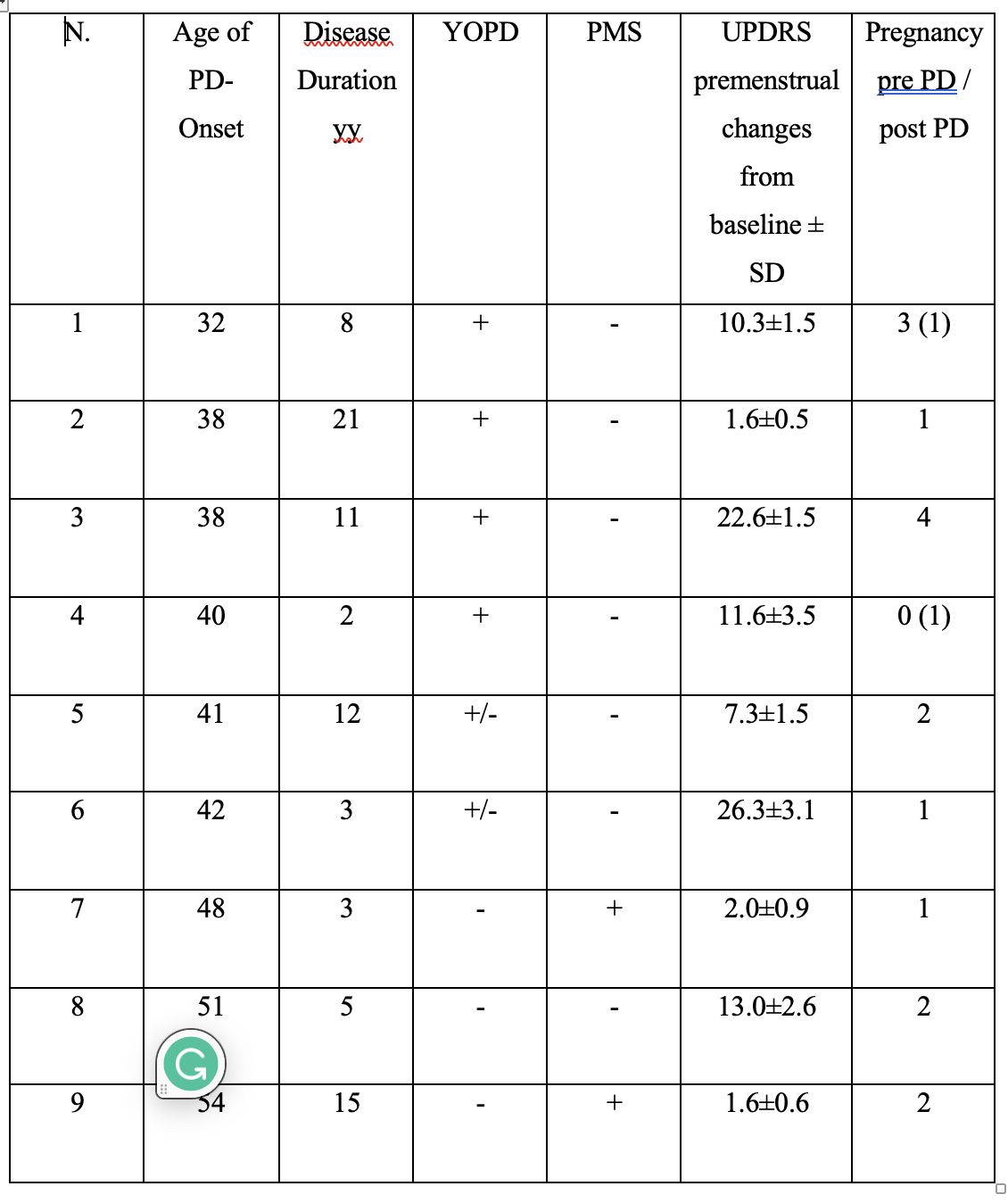Objective: The role of estrogen in dopaminergic pathways and the premenstrual worsening of parkinsonian symptoms.
Background: Female sex hormones, during the menstrual cycle, could influence behaviour and peripheral nociception in the so-called Premenstrual Syndrome, but also there is a debate about their effects on central neurotransmission. Some authors suggest that fluctuating female sex hormones during the menstrual cycle do not significantly alter central dopaminergic neurotransmission, while others proposed that estrogen fluctuations reduces the dopaminergic neurotransmission.
Method: Out of our Movement Disorder database we selected 11 women who had regular menstrual cycles, within the range of 24-35 days. None of the women was pregnant or had taken an oral contraceptive pill prior to the observation. The duration of the observation was 4 months, and 3 full menstrual cycles UPDRS I-III subscale ratings were performed every week by one expert neurologist unaware of the cycle phase of the women. The women had to complete every 3 days a self-rating chart to rule out a diagnosis of PMS. The different phases of the cycle were defined as follows: menstruate- (days 2-6), follicular- (days 9-13), early luteal- (days 16-20), and late luteal phase (days 24-30).
Results: 9 patients completed the observations, 1 patient discontinued the study because of loss of follow-up, and 1 patient was not taken into account at the final evaluation because of irregular menstrual cycles. 6 patients affected by young onset PD and in childbearing age 32-42 years old (38.5±3.6, mean ± SD) and 3 patients in the premenopausal period 48-51 years old (51.0±3) were considered for the final results. All but one (pat. DA) were on L-Dopa and/or dopamine agonist therapy. Changes in UPDRS during premenstrual period are described in Table 1.
Conclusion: Our results confirm the role of estrogen in dopaminergic pathways, and the abrupt reduction of estrogen levels during the perimenstrual period may contribute to reduced responsiveness to dopaminergic treatment during menses.
Worsening of parkinsonian symptoms seems to be related to estrogen levels, particularly its nadir level, rather than a premenstrual syndrome.
Estrogen impacts nigrostriatal functions at multiple levels, including synthesis, release, reuptake, and dopamine receptor expression in the basal ganglia. A high level of estrogen appears to be neuroprotective, but further investigations are required.
References: 1. Quinn NP, Marsden CD. Menstrual-related fluctuations in Parkinson’s Disease. Mov Disord 1986;1:85-87.
2. Abel KM, O’Keane V, Sherwood RA, Murray RM. Plasma homovnillic acid profile at different phases of the ovulatory cycle in healthy women. Biol Psychatry 1996;39:1039-1043.
3. Roeder HJ, Leira EC. Effects of the Menstrual Cycle on Neurological Disorders. Curr Neurol Neurosci Rep. 2021 May 10;21(7):34. doi: 10.1007/s11910-021-01115-0. PMID: 33970361.
4. Amin F, Davison M, Davis KL. Homovanillic acid measurements in clinical research: a review of methodology. Schizophr Bull1992;18:123-147
5. Hafner H, Behrens S, De Vry J, Gattaz WF. An animal model for the effects of estradiol on dopamine-mediated behaviour:implications for the sex differences in schizophrenia. Psychiatry Res 1991;38:124-134.
6. Seeman MV Current autcome in schizophrenia:men vvs women. Acta Psychiatr Scand1986;73 :609-617.
7. Hammarbäck S, Backström T, MacGibbon-Taylor B Diagnosis of premenstrual tension syndrome: description and evaluation of a procedure for diagnosis and differential diagnosis. J Psychosom Obstst Gynaaecol 1989;:10:25-42.
8. Factor SA .Acetazolamide therapy of menstrual-related fluctuations in Parkinson’s Diseases. Mov Disord 1993;2:240-241.
9. Horstink MWIM, Strijks E, Dluzen DE. Estrogen in Parkinson’s Disease. In: Parkinson’s Disease, Advances in Neurology, Vol 91, eds:A. Gordin, S. Kaakkola, and H Treräväinen. Lippincott Williams & Wilkins, Philadelphia 2003
10. Kompliti K, Comella CL, Jaglin JA, Leurgans S, Raman R, Goetz CG. Menstrual-related changes in women with Parkinson’s Disease. Neurology 2000, 55:1572-1574.
11. Thulin P, Carter JH, Nichols MD, Kurth M, Nutt JG. Menstrual-cycle related changes in Parkinson’s Disease. Neurology 1996, 46:A376
12. Saunders-Pullman RJ, Gorden-Elliott J, Parides M, Fahn S, Saunders HR, Bressman S. The effect of estrogen replacement on early Parkinson’s Disease. Neurology 1998;52:1417-1421
13. Blanchet PJ, Fang J, Hyland K, Arnold LA, Mouradian MM, Chase TN. Short-term effects of high-dose 17beta-estradiol in postmenopausal PD patients: a crossover study. Neurology 1999;53:91-95.
14. Kompoliti K, Adler CH, Raman R, Pincus JH, Leibowitz MT, Ferry JJ, Blasucci L, Caviness JN, Leurgans S, Chase WM, Yones LC, Tan E, Carvey P, Goetz CG. Gender and pramipexole effects on levodopa pharmacokinetics and pharmacodynamics. Neurology 2002,58(9):1418-1422.
15. Tsang KL, Ho SL, Lo SK. Estrogen improves motor disability in parkinsonian postmenopausal women with motor fluctuations. Neurology 2000, 54(12):2292-2298.
16. Mizuta E, Yamasaki S, Nakatake M, Kuno S. Neuroleptic malignant syndrome in a parkinsonian women during the premestrual period. Neurology 1993;1048-1049.
17. Pfeifer RF, Sucha EL. „On-off“ – induced lethal hyperthermia. Mov Disord 1989;4:338-341.
18. Shulman LM, Minagar A, Weiner WJ. The effect of pregnancy in Parkinson’s Disease. Mov Disord, 2000;15:132-135.
19. Hagell P, Odin P, Vinge E. Pregnancy in Parkinson’s Disease. A review of the literature and a case report. Mov Disord 1998;13:34-38.
20. De Mari M, Zenzola A, Lamberti P. Antiparkinsonian treatment in pregnancy. Mov Disord 2002, 2:28-432.
21. Cagnacci A, Melis GB, Soldani R et al. Altered neuroendocrine regulation of luteinizing hormone secretion in postmenopausal women with Parkinson’s Disease. Neuroendocrinology 1991;53:549-555.
22. Kuno S, Mizuta E, Yamasaki S. Neuroleptic malignant syndrome in parkinsonian patients: risk factors. Eur Neurol 1997;38 Suppl 2:56-59.
23. Martignoni E, Nappi RE, Citterio A, Calandrella D, Corengia E, Fignon A, Zangaglia R, Riboldazzi G, Pacchetti C, Nappi G. Parkinson’s Disease and reproductive life events. Neurol Sci 2002;23:S85-S86.
24. Sprenger FS, Seppi K, Wolf E, Poewe W. Perimenstrual Fluctuations in Two Siblings With Early-Onset Parkinson’s Disease. Mov Disord Clin Pract. 2014 May 19;1(2):125-127. doi: 10.1002/mdc3.12036. PMID: 30363847; PMCID: PMC6183192.
25. Dluzen D, Horstink M. Estrogen as neuroprotectant of nigrostriatal dopaminergic system: laboratory and clinical studies. Endocrine. 2003 Jun;21(1):67-75. doi: 10.1385/endo:21:1:67. PMID: 12777705.
To cite this abstract in AMA style:
A. Thomas, D. Calisi, M. de Rosa, P. Ajdinaj, S. Sensi, M. Onodrj. Premenstrual worsening of UPDRS motor scale in women affected by Parkinson’s Disease [abstract]. Mov Disord. 2023; 38 (suppl 1). https://www.mdsabstracts.org/abstract/premenstrual-worsening-of-updrs-motor-scale-in-women-affected-by-parkinsons-disease/. Accessed December 31, 2025.« Back to 2023 International Congress
MDS Abstracts - https://www.mdsabstracts.org/abstract/premenstrual-worsening-of-updrs-motor-scale-in-women-affected-by-parkinsons-disease/

